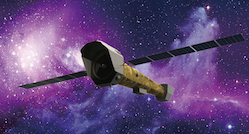ATHENA

The Advanced Telescope for High ENergy
Astrophysics (ATHENA) is an X-ray observatory planned for launch
in 2034 aboard an Ariane 6 expendable launch vehicle.
The mission was selected and now under development by the European Space Agency (ESA)
as part of their Cosmic Vision program to address the Hot and Energetic Universe
science theme. The mission is an ESA led project with contributions from institutes
in Europe, United States, and Japan.
ATHENA has a 12 m focal length X-ray telescope with a large effective area.
X-rays are collected by two focal plane instruments: the Wide Field Imager (WFI)
and X-ray Integral Field Unit (X-IFU). The observatory is placed in a halo orbit
around the Earth-Sun L2 Lagrange point with a nominal mission lifetime of 5 years
with possible extension of a further 5 years. The L1 orbit is being evaluated as
back-up option.
ATHENA is a down-sized version of the abandoned NASA/JAXA/ESA International
X-ray Observatory (IXO), which itself was a merger of the ESA XEUS and NASA
Constellation-X mission proposals.
ATHENA includes two different detectors, the Wild Field Imager (WFI) and
X-ray Integral Field Unit (X-IFU), which share optics with a single 12 m focal length
X-ray telescope.
The telescope uses grazing incidence silicone pore optics to a provide 5-arcsec
Half Energy Width angular resolution and an effective area ≥1.4 m2 at
1 keV, and ≥0.25 m2 at 6 keV.
An instrument switching mechanism, based on a set of hexapods, allows each of the two
instruments to be located at the mirror focus at any given time. The same mechanism
allows to defocus the mirror Point Spread Function (PSF), permitting to increase the
capability of the X-IFU to observe bright X-ray sources.
The WFI detector comprises a Large Detector Array (LDA) and a Fast Detector (FD)
both using depleted p-channel field-effect transistors (DEPFET). The LDA is an
array of 2×2 detectors, each with 512×512 pixels, with a time resolution
in full frame of 5 ms. The FD optimized for bright point sources is an array of
64×64 pixels and
allows a time resolution 80 µs. The WFI is sensitive to X-rays between 0.2 to 15
keV, an energy resolution of ≤170 eV at 7 keV, a pixel size of 2.2″ and
the 40″×40′ field of view.
The X-IFU is an X-ray calorimeter using an array of
cryogenically cooled transition edge detectors. It has a 10 µs
timing accuracy, a spectral resolution of 2.5 eV at or below 7 keV, a field of view of
5′, a pixel size of 5″ and is sensitive across the spectral range
0.2–12 keV.
ATHENA science goals includes:
- studying how matter assembles within galaxies and galaxy
clusters
- measuring the history of the chemical compisition of the
Universe through time
- studying acceration processing in compact objects
- finding the earliest super-massive black holes and tracing their growth
despite the obsuration of heavy dust and gas
- studying transient phenomena such as gamma-ray burst sources with a
fast target of opportunity system
[ATHENA at ESA]
[ATHENA at EU]
[All Missions]
[by Time]
[by Energy]
Page authors: Lorella Angelini Jesse Allen
HEASARC Home |
Observatories |
Archive |
Calibration |
Software |
Tools |
Students/Teachers/Public
Last modified: Monday, 23-Oct-2023 15:05:21 EDT
|